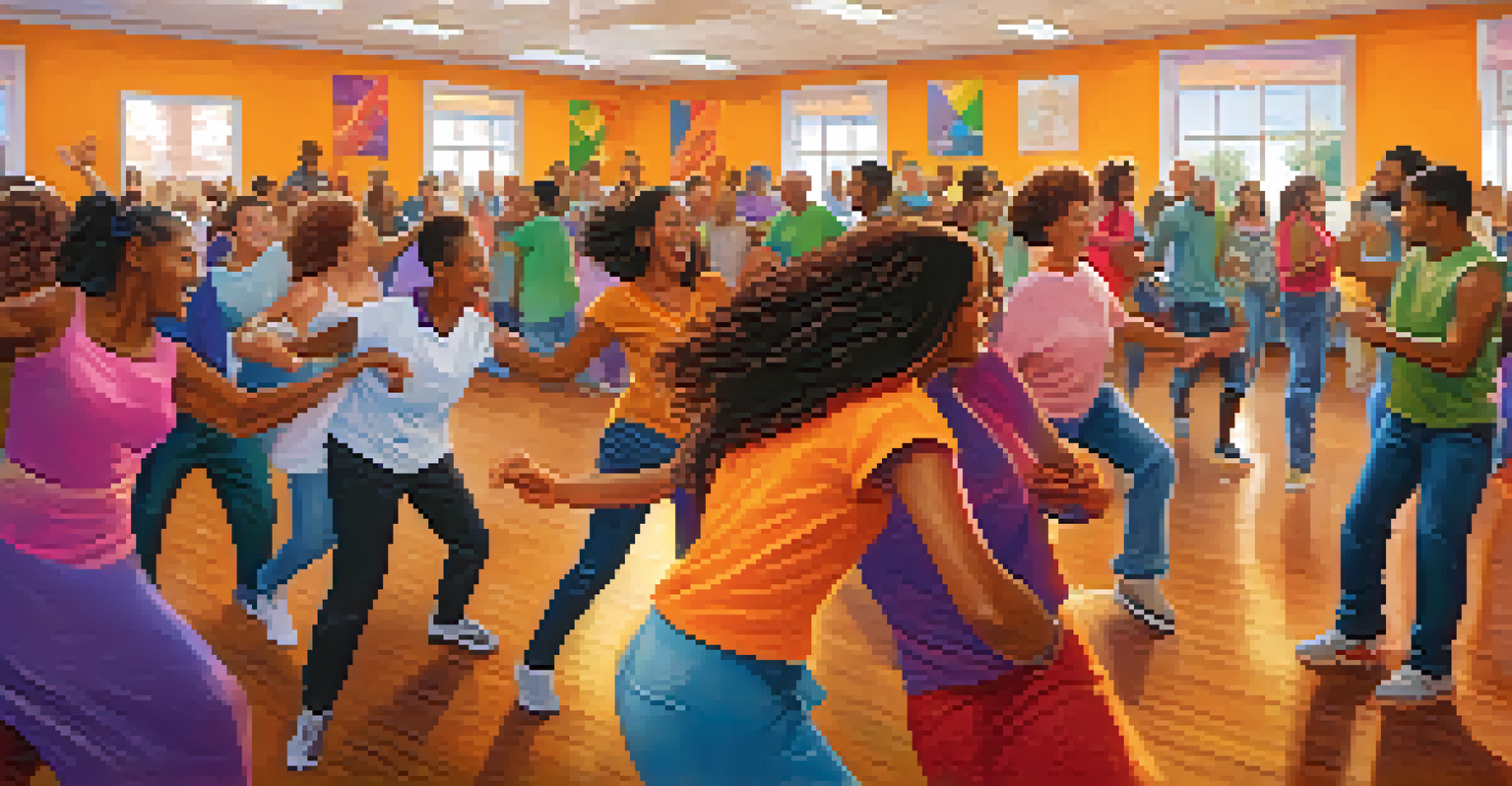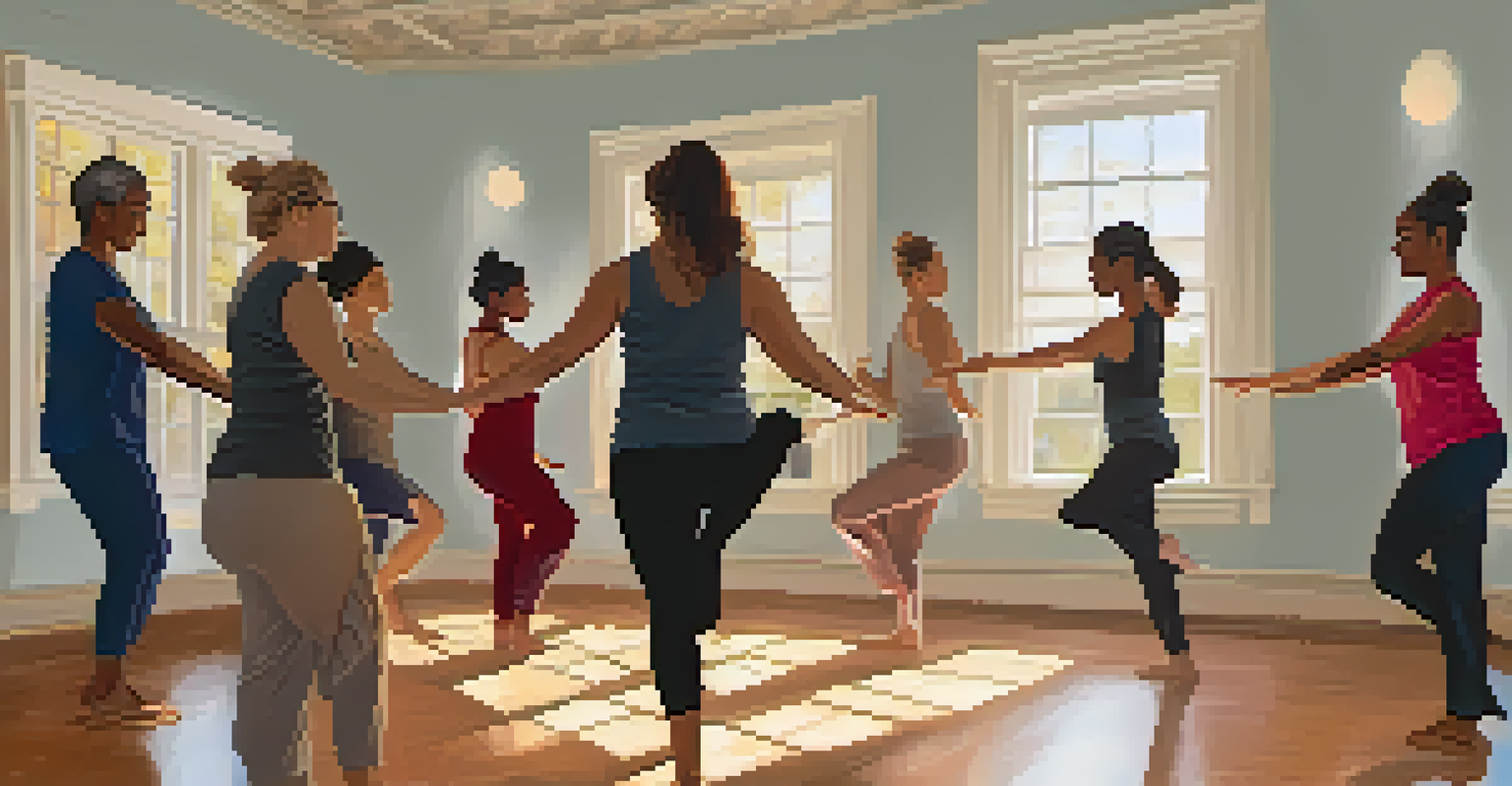The Connection Between Dance and Emotional Healing Processes

Understanding the Emotional Benefits of Dance
Dance is more than just a physical activity; it serves as a powerful emotional outlet. Many people find that moving their bodies to music can help them express feelings that are difficult to articulate. This expression can lead to a sense of relief and release, making dance a therapeutic experience.
Dance is the hidden language of the soul.
For instance, consider how someone might feel after a tough day. Instead of bottling up emotions, they might choose to dance it out in their living room, letting go of stress and frustration. This connection between movement and emotion illustrates how dance can be a form of self-care.
Moreover, studies have shown that dance can trigger the release of endorphins, the body's natural mood lifters. This chemical reaction can help improve overall emotional well-being, reinforcing the idea that dance is not just about physical movement but also about emotional healing.
Dance as a Form of Self-Expression
Self-expression is a vital component of emotional healing, and dance provides a unique platform for it. When we dance, we communicate feelings and experiences that might otherwise remain unspoken. Through movement, we can tell our stories and share our struggles in a way that resonates deeply with ourselves and others.

For example, a contemporary dancer might express themes of grief or joy through their choreography, allowing the audience to connect with their emotions on a personal level. This kind of expression can validate our feelings and make us feel less alone in our experiences.
Dance as an Emotional Outlet
Engaging in dance allows individuals to express and release emotions, providing a therapeutic experience.
Additionally, participating in group dance settings can foster a sense of community, where shared experiences enhance emotional connections. This collective expression can be incredibly healing, as it reminds us that we are not isolated in our feelings.
The Science Behind Dance and Emotions
Research supports the idea that dance has significant emotional benefits. Studies have shown that engaging in dance can lower stress levels and increase feelings of happiness. The rhythmic movements and music can alter brain chemistry, promoting feelings of well-being.
Dancing is like dreaming with your feet.
Moreover, the act of moving to music can stimulate the release of oxytocin, often referred to as the 'love hormone.' This hormone plays a crucial role in social bonding, enhancing feelings of connection and trust, which can be especially beneficial during emotional healing processes.
Understanding the science behind dance helps to demystify its emotional impact. It emphasizes that the benefits of dance are not just anecdotal; there is substantial evidence supporting its role in emotional well-being.
Dance Therapy: A Structured Approach to Healing
Dance therapy is a recognized form of therapy that utilizes movement to promote emotional, cognitive, and physical integration. Certified dance therapists guide individuals through movements that are designed to help them process emotions and experiences. This structured approach can provide a safe space for healing.
For instance, in a dance therapy session, participants might be encouraged to move in ways that reflect their current emotional state. This can help them confront feelings they may be avoiding and facilitate a deeper understanding of their emotions.
Science Supports Dance Benefits
Research shows that dance lowers stress and boosts happiness by altering brain chemistry and releasing hormones.
Dance therapy is particularly effective for individuals dealing with trauma. It offers an alternative means of communication that can bypass verbal barriers, allowing for a more profound healing experience.
Cultural Perspectives on Dance and Healing
Various cultures have long recognized the healing power of dance, often incorporating it into their healing rituals. For example, traditional African dance is used not just for celebration but also for community healing and spiritual connection. These cultural practices highlight the universal nature of dance as a healing tool.
In many Indigenous cultures, dance is intertwined with storytelling and healing ceremonies, offering a collective approach to emotional and spiritual well-being. This communal aspect of dance can foster a sense of belonging and support among participants.
Acknowledging these cultural perspectives enriches our understanding of dance as a healing practice. It emphasizes that dance is not just a modern phenomenon but a time-honored tradition across the globe.
Personal Stories of Healing Through Dance
Personal stories can be incredibly powerful in illustrating the healing potential of dance. Many individuals have shared transformative experiences where dance has played a crucial role in their emotional recovery. These narratives often highlight the profound joy and catharsis that movement can bring.
For example, a woman might recount how joining a dance class helped her overcome anxiety after a difficult life event. Through dance, she found not only a means of expression but also a supportive community that encouraged her healing journey.
Cultural Healing Through Dance
Many cultures incorporate dance into healing rituals, highlighting its universal role in emotional and spiritual well-being.
These personal accounts serve as testaments to the impact of dance on emotional health. They remind us that, while the science is important, the individual experience is equally valuable.
Incorporating Dance into Daily Life for Emotional Well-Being
Incorporating dance into your daily routine can be an effective way to enhance emotional well-being. Whether it's a solo dance session in your living room or joining a local class, making time for dance can provide a much-needed emotional boost. The key is to find a style that resonates with you, whether it's ballet, hip-hop, or even freestyle.
Additionally, you don’t need to be a professional dancer to reap the benefits. Simply allowing yourself to move freely to music can be liberating and therapeutic. This kind of spontaneous expression can help you process emotions and improve your mood.

Ultimately, the goal is to make dance a regular part of your life. By doing so, you can cultivate a deeper connection with your emotions and enhance your overall mental health.